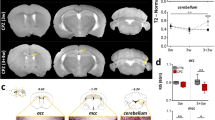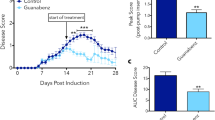Abstract
Multiple sclerosis is an inflammatory demyelinating disorder of the CNS. Recent studies have suggested diverse mechanisms as underlying demyelination, including a subset of lesions induced by an interaction between metabolic insult to oligodendrocytes and inflammatory mediators. For mice of susceptible strains, cuprizone feeding results in oligodendrocyte cell loss and demyelination of the corpus callosum. Remyelination ensues and has been extensively studied. Cuprizone-induced demyelination remains incompletely characterized. We found that mice lacking the type 2 CXC chemokine receptor (CXCR2) were relatively resistant to cuprizone-induced demyelination and that circulating CXCR2-positive neutrophils were important for cuprizone-induced demyelination. Our findings support a two-hit process of cuprizone-induced demyelination, supporting the idea that multiple sclerosis pathogenesis features extensive oligodendrocyte cell loss. These data suggest that cuprizone-induced demyelination is useful for modeling certain aspects of multiple sclerosis pathogenesis.
This is a preview of subscription content, access via your institution
Access options
Subscribe to this journal
Receive 12 print issues and online access
$209.00 per year
only $17.42 per issue
Buy this article
- Purchase on SpringerLink
- Instant access to full article PDF
Prices may be subject to local taxes which are calculated during checkout








Similar content being viewed by others
References
Lucchinetti, C. et al. A quantitative analysis of oligodendrocytes in multiple sclerosis lesions. A study of 113 cases. Brain 122, 2279–2295 (1999).
Lucchinetti, C. et al. Heterogeneity of multiple sclerosis lesions: implications for the pathogenesis of demyelination. Ann. Neurol. 47, 707–717 (2000).
Storch, M.K. et al. Autoimmunity to myelin oligodendrocyte glycoprotein in rats mimics the spectrum of multiple sclerosis pathology. Brain Pathol. 8, 681–694 (1998).
Trapp, B.D. Pathogenesis of multiple sclerosis: the eyes only see what the mind is prepared to comprehend. Ann. Neurol. 55, 455–457 (2004).
Lassmann, H. Experimental models of multiple sclerosis. Rev. Neurol. (Paris) 163, 651–655 (2007).
Lassmann, H., Bruck, W. & Lucchinetti, C. Heterogeneity of multiple sclerosis pathogenesis: implications for diagnosis and therapy. Trends Mol. Med. 7, 115–121 (2001).
Wagner, T. & Rafael, J. Biochemical properties of liver megamitochondria induced by chloramphenicol or cuprizone. Exp. Cell Res. 107, 1–13 (1977).
Matsushima, G.K. & Morell, P. The neurotoxicant, cuprizone, as a model to study demyelination and remyelination in the central nervous system. Brain Pathol. 11, 107–116 (2001).
Ludwin, S.K. & Johnson, E.S. Evidence for a “dying-back” gliopathy in demyelinating disease. Ann. Neurol. 9, 301–305 (1981).
Mahad, D.J. et al. Expression of chemokine receptors CCR1 and CCR5 reflects differential activation of mononuclear phagocytes in pattern II and pattern III multiple sclerosis lesions. J. Neuropathol. Exp. Neurol. 63, 262–273 (2004).
Remington, L.T., Babcock, A.A., Zehntner, S.P. & Owens, T. Microglial recruitment, activation and proliferation in response to primary demyelination. Am. J. Pathol. 170, 1713–1724 (2007).
Cammer, W. The neurotoxicant, cuprizone, retards the differentiation of oligodendrocytes in vitro. J. Neurol. Sci. 168, 116–120 (1999).
Pasquini, L.A. et al. The neurotoxic effect of cuprizone on oligodendrocytes depends on the presence of pro-inflammatory cytokines secreted by microglia. Neurochem. Res. 32, 279–292 (2007).
Gao, X. et al. Interferon-gamma protects against cuprizone-induced demyelination. Mol. Cell. Neurosci. 16, 338–349 (2000).
Liñares, D. et al. Neuronal nitric oxide synthase plays a key role in CNS demyelination. J. Neurosci. 26, 12672–12681 (2006).
McMahon, E.J., Cook, D.N., Suzuki, K. & Matsushima, G.K. Absence of macrophage-inflammatory protein-1alpha delays central nervous system demyelination in the presence of an intact blood-brain barrier. J. Immunol. 167, 2964–2971 (2001).
Iocca, H.A. et al. TNF superfamily member TWEAK exacerbates inflammation and demyelination in the cuprizone-induced model. J. Neuroimmunol. 194, 97–106 (2008).
Charo, I.F. & Ransohoff, R.M. The many roles of chemokines and chemokine receptors in inflammation. N. Engl. J. Med. 354, 610–621 (2006).
Tsai, H.H. et al. The chemokine receptor CXCR2 controls positioning of oligodendrocyte precursors in developing spinal cord by arresting their migration. Cell 110, 373–383 (2002).
Miller, R.H. & Mi, S. Dissecting demyelination. Nat. Neurosci. 10, 1351–1354 (2007).
Carlson, T., Kroenke, M., Rao, P., Lane, T.E. & Segal, B. The Th17-ELR+ CXC chemokine pathway is essential for the development of central nervous system autoimmune disease. J. Exp. Med. 205, 811–823 (2008).
Lindner, M. et al. The chemokine receptor CXCR2 is differentially regulated on glial cells in vivo but is not required for successful remyelination after cuprizone-induced demyelination. Glia 56, 1104–1113 (2008); erratum 57, 465 (2009).
Jurevics, H. et al. Alterations in metabolism and gene expression in brain regions during cuprizone-induced demyelination and remyelination. J. Neurochem. 82, 126–136 (2002).
Kerstetter, A.E., Padovani-Claudio, D.A., Bai, L. & Miller, R.H. Inhibition of CXCR2 signaling promotes recovery in models of multiple sclerosis. Exp. Neurol. 220, 44–56 (2009).
Ransohoff, R.M. & Perry, V.H. Microglial physiology: unique stimuli, specialized responses. Annu. Rev. Immunol. 27, 119–145 (2009).
Cacalano, G. et al. Neutrophil and B cell expansion in mice that lack the murine IL-8 receptor homolog. Science 265, 682–684 (1994).
Ransohoff, R.M. Microgliosis: the questions shape the answers. Nat. Neurosci. 10, 1507–1509 (2007).
McMahon, E.J., Suzuki, K. & Matsushima, G.K. Peripheral macrophage recruitment in cuprizone-induced CNS demyelination despite an intact blood-brain barrier. J. Neuroimmunol. 130, 32–45 (2002).
Shea-Donohue, T. et al. Mice deficient in the CXCR2 ligand, CXCL1 (KC/GRO-alpha), exhibit increased susceptibility to dextran sodium sulfate (DSS)-induced colitis. Innate Immun. 14, 117–124 (2008).
Fuller, M.L. et al. Bone morphogenetic proteins promote gliosis in demyelinating spinal cord lesions. Ann. Neurol. 62, 288–300 (2007).
Lin, W. et al. Interferon-gamma inhibits central nervous system remyelination through a process modulated by endoplasmic reticulum stress. Brain 129, 1306–1318 (2006).
Mason, J.L., Ye, P., Suzuki, K., D′Ercole, A.J. & Matsushima, G.K. Insulin-like growth factor-1 inhibits mature oligodendrocyte apoptosis during primary demyelination. J. Neurosci. 20, 5703–5708 (2000).
Kelchtermans, H., Billiau, A. & Matthys, P. How interferon-gamma keeps autoimmune diseases in check. Trends Immunol. 29, 479–486 (2008).
Glabinski, A.R., Krakowski, M., Han, Y., Owens, T. & Ransohoff, R.M. Chemokine expression in GKO mice (lacking interferon-gamma) with experimental autoimmune encephalomyelitis. J. Neurovirol. 5, 95–101 (1999).
Krakowski, M. & Owens, T. Interferon-gamma confers resistance to experimental allergic encephalomyelitis. Eur. J. Immunol. 26, 1641–1646 (1996).
Tran, E.H., Prince, E.N. & Owens, T. IFN-gamma shapes immune invasion of the central nervous system via regulation of chemokines. J. Immunol. 164, 2759–2768 (2000).
Savarin, C., Bergmann, C.C., Hinton, D.R., Ransohoff, R.M. & Stohlman, S.A. Memory CD4+ T-cell–mediated protection from lethal coronavirus encephalomyelitis. J. Virol. 82, 12432–12440 (2008).
Aboul-Enein, F. & Lassmann, H. Mitochondrial damage and histotoxic hypoxia: a pathway of tissue injury in inflammatory brain disease? Acta Neuropathol. 109, 49–55 (2005).
Mahad, D., Ziabreva, I., Lassmann, H. & Turnbull, D. Mitochondrial defects in acute multiple sclerosis lesions. Brain 131, 1722–1735 (2008).
Chaturvedi, R.K. & Beal, M.F. Mitochondrial approaches for neuroprotection. Ann. NY Acad. Sci. 1147, 395–412 (2008).
Smith, K.J. Sodium channels and multiple sclerosis: roles in symptom production, damage and therapy. Brain Pathol. 17, 230–242 (2007).
Cardona, A.E. et al. Scavenging roles of chemokine receptors: chemokine receptor deficiency is associated with increased levels of ligand in circulation and tissues. Blood 112, 256–263 (2008).
Armstrong, R.C., Le, T.Q., Frost, E.E., Borke, R.C. & Vana, A.C. Absence of fibroblast growth factor 2 promotes oligodendroglial repopulation of demyelinated white matter. J. Neurosci. 22, 8574–8585 (2002).
Liu, L. et al. Severe disease, unaltered leukocyte migration, and reduced IFN-{gamma} production in Cxcr3−/− mice with experimental autoimmune encephalomyelitis. J. Immunol. 176, 4399–4409 (2006).
Cardona, A.E. et al. Control of microglial neurotoxicity by the fractalkine receptor. Nat. Neurosci. 9, 917–924 (2006).
Schreiber, R.C. et al. Monocyte chemoattractant protein (MCP)-1 is rapidly expressed by sympathetic ganglion neurons following axonal injury. Neuroreport 12, 601–606 (2001).
Pernet, V., Joly, S., Christ, F., Dimou, L. & Schwab, M.E. Nogo-A and myelin-associated glycoprotein differently regulate oligodendrocyte maturation and myelin formation. J. Neurosci. 28, 7435–7444 (2008).
Waxman, S.G., Kocsis, J.D. & Nitta, K.C. Lysophosphatidyl choline-induced focal demyelination in the rabbit corpus callosum. Light-microscopic observations. J. Neurol. Sci. 44, 45–53 (1979).
Acknowledgements
We thank W. Stallcup for generously providing antibodies to PDGF receptor alpha and G. Kidd (Cleveland Clinic) for assistance with imaging. We thank G. Matsushima (University of North Carolina Chapel Hill) for helpful discussions regarding the cuprizone model. We thank X. Qu (Cleveland Clinic) for help with TUNEL staining. This research was supported by grants from the National Multiple Sclerosis Society (RG 3580 to R.M.R.), the US National Institutes of Health (NS32151 to R.M.R. and NS36674 to R.H.M.), the Myelin Repair Foundation (R.H.M.) and the Nancy Davis Center Without Walls (R.M.R.).
Author information
Authors and Affiliations
Contributions
L.L. was responsible for day-to-day management of the project, designed and performed experiments, analyzed data, and wrote the initial draft of the manuscript. A.B. and R.H.M. designed and performed the experiments shown in Supplementary Figure 1. L.D., T. Hu and T. He were involved in generating and analyzing Cxcr2−/− mice on the B6 background. They performed experiments and were involved in data analysis and interpretation. C.D. participated in the development and implementation of electron microscopy quantitative methodology. A.C.C. interpreted flow cytometry experiments. D.P.-C. conducted initial LPC studies in Cxcr2−/− mice. K.C. quantified demyelination and assisted in the development of the technique. T.E.L. provided antibodies to CXCR2, participated in experimental design and provided input into the manuscript. R.H.M. participated in all aspects of experimental design and generation of the manuscript. R.M.R. conceived the project, designed the experiments and wrote the paper.
Corresponding author
Ethics declarations
Competing interests
The authors declare no competing financial interests.
Supplementary information
Supplementary Text and Figures
Supplementary Figures 1–10 (PDF 1092 kb)
Rights and permissions
About this article
Cite this article
Liu, L., Belkadi, A., Darnall, L. et al. CXCR2-positive neutrophils are essential for cuprizone-induced demyelination: relevance to multiple sclerosis. Nat Neurosci 13, 319–326 (2010). https://doi.org/10.1038/nn.2491
Received:
Accepted:
Published:
Issue Date:
DOI: https://doi.org/10.1038/nn.2491



